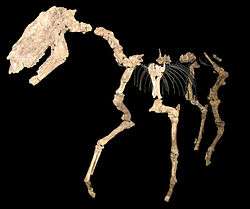Hipparion
| Hipparion Temporal range: Mid Miocene to Pleistocene,[1] 23–0.781 Ma | |
|---|---|
 | |
| H. laromae skeleton | |
| Scientific classification | |
| Kingdom: | Animalia |
| Phylum: | Chordata |
| Class: | Mammalia |
| Order: | Perissodactyla |
| Family: | Equidae |
| Genus: | Hipparion De Christol, 1832 |
| Species | |
| |
Hipparion (Greek, "pony") is an extinct genus of horse living in North America, Asia, Europe, and Africa during the Miocene through Pleistocene ~23 Mya—781,000 years ago, existing for 22 million years.
Its habitat or biome would be that of non-forested, grassy plains, shortgrass prairie or steppes.
Taxonomy

Hipparion was named by de Christol[2] (1832) with it assigned the type European H. prostylum. It was assigned to Equidae by de Christol (1832), Thurmond and Jones (1981) and Carroll (1988); and to Hipparionini by MacFadden (1998).[3][4][5]
Morphology
Hipparion resembled the modern horse, but still had two vestigal outer toes (in addition to its hoof). These did not touch the ground. Hipparion was about 1.4 metres (13.3 hands) tall at the shoulder.[1]
Body mass
Three specimens were examined by Legendre and Roth for body mass.[6]
- Specimen 1 was estimated to weigh: 118.9 kg (260 lb)
- Specimen 2 was estimated to weigh: 69.4 kg (150 lb)
- Specimen 3 was estimated to weigh: 62.8 kg (140 lb)
Species
- H. concudense Pirlot, 1956
- H. dietrichi Wehrli, 1941
- H. fissurae Crusafont and Sondaar, 1971
- H. forcei Richey, 1948
- H. laromae Pesquero et al., 2006
- H. lufengense Sun, 2013[7]
- H. molayanense Zouhri, 1992
- H. phlegrae Lazaridis and Tsoukala, 2014[8]
- H. prostylum Gervais, 1849
- H. sellardsi Matthew and Stirton, 1930
- H. shirleyae MacFadden, 1984
- H. tehonense (Merriam, 1916)
References
- 1 2 Palmer, D., ed. (1999). The Marshall Illustrated Encyclopedia of Dinosaurs and Prehistoric Animals. London: Marshall Editions. p. 257. ISBN 1-84028-152-9.
- ↑ Christol, Jules de - La France savante XVIIe-XXe
- ↑ J. T. Thurmond and D. E. Jones. 1981. Fossil Vertebrates of Alabama 1-244
- ↑ R. L. Carroll. 1988. Vertebrate Paleontology and Evolution. W. H. Freeman and Company, New York 1-698
- ↑ B. J. MacFadden. 1998. Equidae. In C. M. Janis, K. M. Scott, and L. L. Jacobs (eds.), Evolution of Tertiary Mammals of North America 1:537-559
- ↑ S. Legendre and C. Roth. 1988. Correlation of carnassial tooth size and body weight in recent carnivores (Mammalia). Historical Biology 1(1):85-98
- ↑ Bo-Yang Sun (2013). "The Miocene Hipparion (Equidae, Perissodactyla) from Shihuiba Locality, Lufeng, Yunnan". Vertebrata PalAsiatica 51 (2): 141–161.
- ↑ Georgios Lazaridis and Evangelia Tsoukala (2014). "Hipparion phlegrae, sp. nov. (Mammalia, Perissodactyla): a new species from the Turolian locality of Kryopigi (Kassandra, Chalkidiki, Greece)". Journal of Vertebrate Paleontology 34 (1): 164–178. doi:10.1080/02724634.2013.781033.
| Wikimedia Commons has media related to Hipparion. |